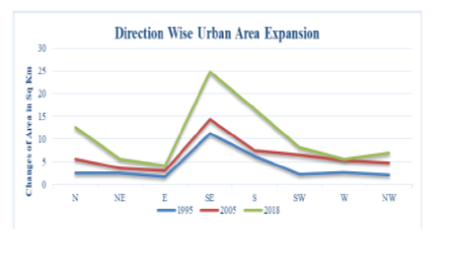
Geo-Eye
Department of Geography & GIS

Department of Geography & GIS

Geo-Eye
Year: 2019, Volume: 8, Issue: 2, Pages: 6-11
Review Article
Aishwarya S Hanjagi1, P Surendra2, Shahnin Irfan3, Ashok D Hanjagi4
1M.Sc. Student, Department of Geography, Bangalore University, Karnataka, Bengaluru, India
2Assistant Professor, Department of Geography, Bangalore University, Bengaluru, Karnataka,
India
3Research Scholar, Department of Geography, Bangalore University, Bengaluru, Karnataka, India
4Professor, Department of Geography, Bangalore University, Bengaluru, Karnataka, India
Received Date:11 June 2019, Accepted Date:21 November 2019
Even though they are conceptually different, the terms urban growth, urban extension, and urban sprawl are occasionally used interchangeably. An increase in the urbanised land cover is referred to as urban growth. Urban extension is one method of urban expansion. Urban sprawl is the term for urban growth that occurs as a result of unplanned or spontaneous urban development. Urban sprawl usually has negative connotations, associated with the generation or intensification of complex urban problems, such as land, water, and air pollution, with their consequent negative impacts on human health (Alberti, 1999; Antrop, 2004; Dickson, Baker, Hoornweg, & Asmita, 2012; Kumar & Pandey, 2013; Marshall, Pielke, Steyaert, & Willard, 2004; Pathan, Shukla, Patel, Patel, & Mehta, 1991; Rivas, Hernandez, & Cueto, 2003;Claudia, Sandra, Sergio, Jorge, 2019). Manya tauk, in the Indian state of Karnataka, is one of the fastest growing urban centres. In the last three decades, the taluk has seen a surge in urban growth and development in all directions. And it is expected to grow at a faster rate in the future. The satellite images of LandSat 5 TM, LandSat 7 ETM+ and LandSat 8 OLI/TIRS sensors for years 1995, 2005 and 2018 respectively is collected from Earth Explorer provided by USGS. Using a shape file of the study area downloaded from Diva GIS, supervised classification was also performed for the study areas using ERDAS Imagine 2014, and finally an agricultural thematic map was created using Arc GIS 10.2 version.
Keywords: Urban Growth; GIS; Remote sensing
© 2019 Hanjagi et al. This is an open-access article distributed under the terms of the Creative Commons Attribution License, which permits unrestricted use, distribution, and reproduction in any medium, provided the original author and source are credited.
Published By Bangalore University, Bengaluru, Karnataka
Subscribe now for latest articles and news.